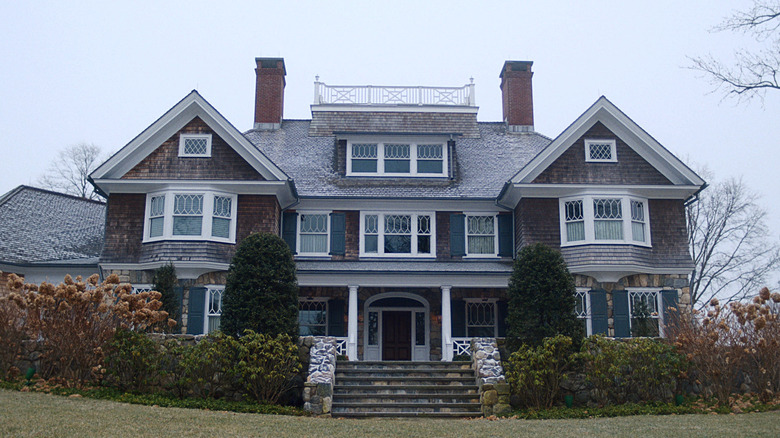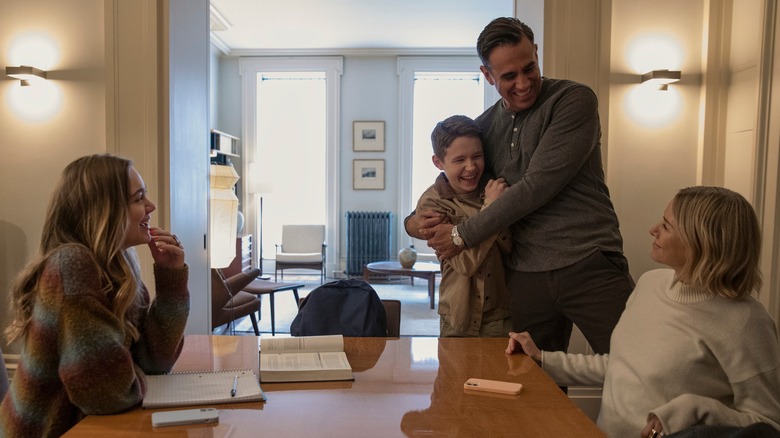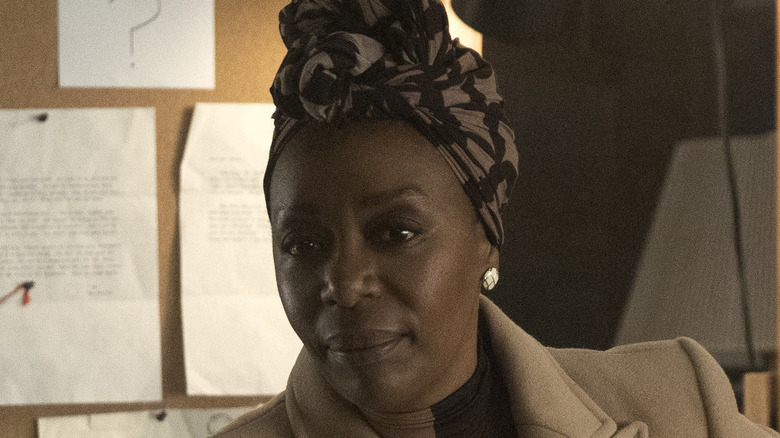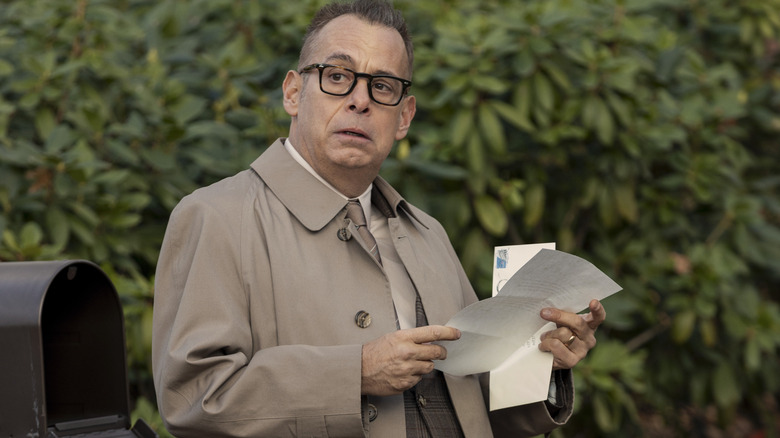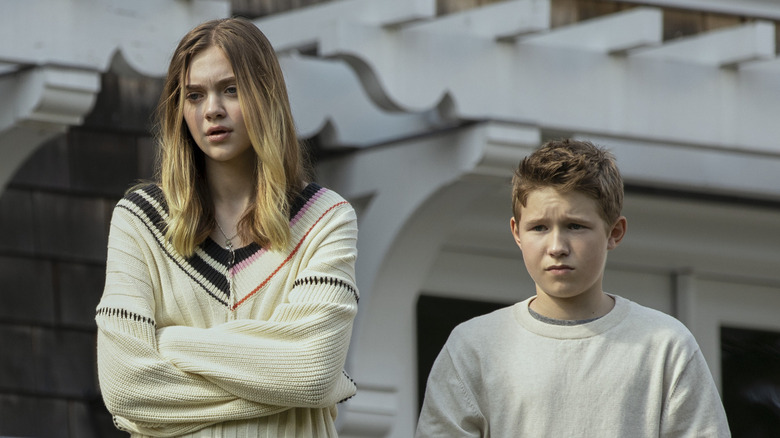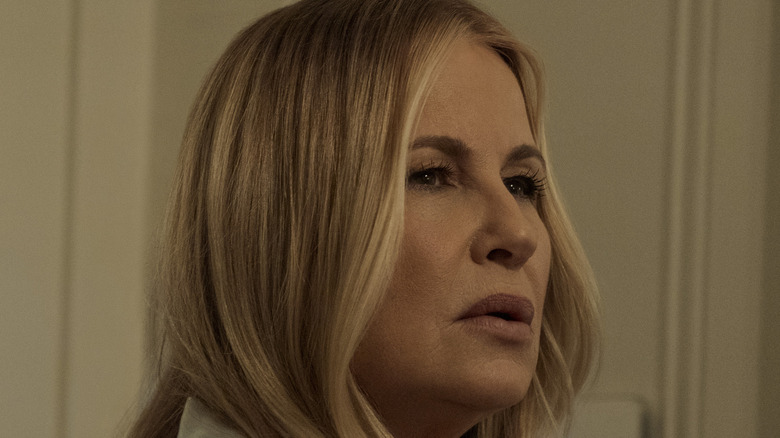Everything The Watcher Gets Wrong About The True Story
The newest true crime story to make its way to streaming is the infamous case of 657 Boulevard Avenue and the mysterious stalker who gives the series its title — "The Watcher." The real-life case unfolded mainly in 2014 and 2015, when the Broaddus family purchased the stunning Boulevard Avenue home in Westfield, New Jersey, and began receiving disturbing, potentially threatening letters in the mail from the titular Watcher. Though the actual case is about as mysterious as modern true crime cases get, the fictionalized Netflix original series version is exponentially more baffling. Most of that difference lies in the adaptation by filmmaker Ryan Murphy, the modern horror king known for "American Horror Story" and "Dahmer – Monster: The Jeffrey Dahmer Story."
In Murphy's hands, the series transforms the real Watcher and their letters into a twisting, turning flume ride whose rapids are bloody and whose ending may never come. The series is a true dramatization, supplementing the actual eeriness with more surprise, betrayal, mystery, murder, and potentially even a touch of the supernatural. For fans of the show, the real case it's based on, or both, here's a look at everything "The Watcher" gets wrong about the true story.
The real 657 Boulevard Avenue
The entirety of "The Watcher" Season 1 centers around the house at 657 Boulevard Avenue in Westfield, New Jersey, the same address as the house central to the real-life case. Despite the real-life family's request to change their names and appearances, they had no qualms about the actual address being used, as they've long since moved on (at least geographically). Though the addresses are the same, the actual houses — their size, layout, and monetary value — are drastically different.
Though both versions fluctuate in price, as with all real estate, the series version mainly hovers between $2.7 million and $3.3 million, while the real house was purchased by the Broadduses — known in the series as the Brannocks — for only $1.3 million. Accordingly, the house shown in the series is much, much larger than the real house, and for good reason — the house that Netflix chose for the series is a manor in Rye, New York, which spans more than 10,000 feet, more than twice the 3,800+ of the real house. And though the six-bedroom, four-bathroom setup of the real house is impressive enough, the Netflix version boats a whopping 19 rooms, along with, according to the New York Post, a "movie theater, an indoor basketball court, a full gym, a golf simulator" and even a "70-foot swimming pool and spa."
The Broadduses didn't actually live there
The Netflix series focuses on Dean Brannock (Bobby Cannavale) and Nora Brannock (Naomi Watts), as well as their children Ellie (Isabel Gravitt) and Carter (Luke David Blumm), the family with the dubious honor of purchasing 657 Boulevard Avenue. The real family is a bit different, consisting of Derek and Maria Broaddus and their three children.
The plot of "The Watcher" is heavily dependent on the fact that the Brannocks move into the house, and only then begin receiving the harassing letters, as well as the escalating acts of terror that ensue. The murder of Carter's pet ferret, for example, represents a major raising of the stakes for both the series and its central family. In the real case of the Watcher, no ferrets or any other animals were harmed, and that's for one simple reason: the Broadduses never actually moved into the house.
Per the popular article from The Cut that brought this case to a wide audience, it was only three days after the Broadduses closed on the property that the first Watcher letter arrived, and the couple reacted immediately. They met with police, kept their kids at another home in Westfield, and stayed on high alert whenever they visited. Their absence became source material for the Watcher's third letter, which read in part, "Where have you gone to? 657 Boulevard is missing you."
Theodora Birch
Though the majority of the characters in "The Watcher" are stand-ins for or were at least inspired by real people, series creators invented private investigator Theodora Birch (Noma Dumezweni) from scratch — and thank goodness they did, because she's one of the series' best parts.
The Brannocks hire Birch early in the season at the suggestion of local detective Rourke Chamberland (Christopher McDonald), who is less able to help due to legal red tape. Over the course of the series' seven episodes, Birch unfurls the rich tapestry of her personal life, including a career as a jazz singer, a corrupt, cheating ex, and a terminal cancer diagnosis. She also gradually teases out more and more elements of the Brannocks' case, often jumping the story forward through roundtable debriefings with Dean and Nora.
Any fans upset about the accuracy of Birch's presence will be glad to know that the change was an upgrade. Though the Broadduses did hire an impressive-sounding assemblage of private investigators, including Frank Shea, an ex-FBI agent, and another ex-FBI agent — this one the real-life basis for Clarice Starling in "The Silence of the Lambs" (per The Cut) — none of them turned up much in the way of leads, nor did they supplement the Broadduses' drama with their own rich backstories.
Former owners
Another invention of Murphy and company for "The Watcher" is the long, storied history of the house and its numerous former owners. In the actual case, the only former owners to become involved in any capacity were the most recent occupants, the Woodses, and their involvement was minimal. The Woodses did receive their own letter from the Watcher, but it came just days before they moved out and was dismissed as inconsequential. The couple had lived there for 23 years without incident, often even leaving their doors unlocked, and never felt threatened. On top of that, as The Cut reports, not one former owner before the Woodses recalled anything odd or sinister.
In contrast, the Netflix adaptation of events adds a long series of characters with special ties to the house, both its former owners and former visitors, many of whom received their own Watcher letters. There's most recent owner Andrew Pierce (Seth Gabel), who claimed to not only receive multiple letters but said he actually uncovered evidence of a neighborhood Satanic cult that drinks the blood of children to stay young. There's John Graff/William Webster (Joe Mantello), a former owner who also received letters, and who eventually went mad and murdered his entire family before escaping into anonymity. There is also retired local professor Roger Kaplan (Michael Nouri), who adulated the house as a child and once a professor, assigned his students the assignment of writing anonymous odes to houses and leaving them in their mailboxes — the Watcher's exact M.O.
John Graff is John List
John Graff, the creepiest and most mysterious former owner of 657 Boulevard Avenue, is an invention for the show, a way of adding more secrecy and darkness to the house's history. In the series, Graff was an unremarkable office drone who gradually slipped into madness, partially egged on by the Watcher's letters. He killed his wife and two children without remorse and even violated their bodies in unspecified ways. He gets away with his crimes and evades detection for decades, not being identified until Birch and Dean realize that he just recently snuck into the house and spoke to Dean. In reality, Derek Broaddus never met with any serial-killer former owner, nor does 657 Boulevard Avenue have any such massacres in its history — but Westfield does.
John Graff is based in part on real-life murderer John List, who may have never lived at 657 Boulevard Avenue, but was coincidentally also a Westfield resident. Like Graff, List shot and killed his wife, elderly mother, and children. Also like Graff, List managed to disappear for years, in List's case almost 18 of them. In addition to those major events, a number of minor details link the two, such as both arranging the bodies into a "makeshift morgue" (per NJ.com) and their shared connection to sandwiches — List sat down to eat one after murdering his last family member and Graff fixes one while vaguely threatening Dean.
The Dean conspiracies
The middle episodes of "The Watcher" add more challenges to The Brannocks' already overwritten list, the largest two of which are Dean's alleged racism and infidelity. Furious at Dean forbidding Dakota (Henry Hunter Hall) from seeing her, Ellie exacts an overblown revenge by posting a TikTok falsely accusing her father of being racist. Shortly after that, Dakota finds and shares a security camera video of what seems to be Dean engaging in an extramarital affair with an underage-looking girl.
Despite the rapid reveal that both accusations are false and both accusers are merely trying to enact revenge on Dean, the life-changing damage is done. The videos reach Dean's boss, who reacts unilaterally and immediately, preventing Dean from becoming a partner in his firm, and later even firing him. For the remainder of the series, Dean interviews for new jobs with seemingly zero success, even ending the season still unemployed. Though these additional struggles, coming at the midpoint and continuing to the season's end, represent a textbook storyteller's tool for ramping up the drama, they are fictional.
Despite being forced to sell 657 Boulevard for a substantial loss and considering the whole ordeal the "worst years" of his life (per the Hollywood Reporter), the real Derek Broaddus didn't face the same irreversible ruin and stigma that Dean Brannock did, and still enjoys professional success.
Dean vs. Nora
Partially as a result of the two-pronged attack on Dean's character — the frame jobs accusing him of racism and infidelity — the Brannocks' relationship tanks. Dean and Nora separate and even approach a divorce, evolving the central conflict from the Brannocks vs. the Watcher into Dean vs. Nora vs. the Watcher.
As Season 1 ends, Dean's obsession with the house, even though the couple had long since sold it, seems to offset whatever progress he has been making in therapy. Nora, more aware of Dean's monomania than he thinks, actively follows him in order to surveil him, and it seems like divorce is more of an inevitability than a possibility. However, this conflict is almost entirely invented for the show, as the real Derek and Maria Broaddus faced their own Watcher as a relatively solid unit, almost exclusively making moves to protect themselves and their children — assuming they weren't behind the entire Watcher case themselves.
Ever since the Broadduses managed to free themselves of the entire Watcher ordeal, they've kept a low profile (via People), living an as unremarkable, Watcher-less life as they've been able. Based on their social media, the Broaddus family is still intact and by all accounts happy.
The Gamer
Another character created for "The Watcher" is Dakota (Henry Hunter Hall), the young entrepreneur who volunteers his security company to help bring the Brannocks peace of mind. He becomes an integral figure in the story, not only thanks to his security system but also for leaking the video of Dean's alleged affair and for dating Ellie. Though Dakota is a Netflix original character, he does have a fascinating real-world inspiration who gave the case one of its most tantalizing and mysterious leads.
The real person, dubbed by the popular true crime series Buzzfeed Unsolved as the Gamer, is one of the more plausible candidates for the Watcher — partially because he goes by the Watcher. According to the Cut, Westfield detective Barron Chambliss was on a stakeout outside of 657 Boulevard one night when he noticed a car linger outside the home for a suspiciously long time. He traced the vehicle back to a local woman whose boyfriend apparently used "The Watcher" as one of his handles in online video games. When contacted, the Gamer agreed to come into the police station for questioning, but then never appeared. As there wasn't enough evidence to arrest or detain him, he was never questioned, and the amount to which he was involved in the Watcher letters is still unknown.
The Children's Crusade
Already in the first letter by the real-life Watcher, the unknown voyeur makes it clear that the Broaddus children are one of their primary focuses. "You have children," they wrote. "I have seen them. So far I think there are three that I have counted." Even creepier is the fact that the Watcher refers to the children as "young blood" and promises that "Once I know their names I will call to them and draw them too [sic] me." Because of the threatening, predatory nature of the first letter, the Broadduses kept their children at another home in Westview, never moving them into 657 Boulevard and only rarely taking them to visit the house. When the second letter arrived, reading "I am pleased to know your names now and the name [sic] of the young blood you have brought to me" — suggesting the Watcher was able to hear the family speaking in the house — Derek and Maria kept their three children from visiting at all.
Due to this protection, none of the three Broaddus children were involved in the Watcher case in any significant way, other than their mention in the letters. In fact, the children never even learned of the Watcher case until it had become a media sensation. In "The Watcher," every instance of Ellie and Carter's trauma — and even Ellie's crucial detective work, like when she found the "Ode to a House" Facebook group — is a work of fiction.
The violence
For as massive a media sensation as the Watcher case was, and as enduring an urban legend as the whole affair has become, the actual events were tame when compared to those in "The Watcher." The complete tally of the Watcher's harassment is limited to, as the Cut reports, four letters (and perhaps a fifth addressed to another nearby home) and potentially a construction sign ripped out of the ground. Although this is certainly still enough to warrant fear and precaution for any parents, the Watcher case wasn't proven to include any violence, trespassing (except possibly to grab a sign from the lawn), destruction (again: except perhaps the sign), or personal confrontations at all. That makes the many hostile encounters and acts of violence in "The Watcher" a far cry from the truth.
In "The Watcher," both Carter's pet ferret and Karen Calhoun's (Jennifer Coolidge) dog Baron are found dead and bloody inside the house, suggesting murder by a trespassing Watcher. In addition, Dean is involved in numerous shouting and shoving matches with various neighbors and suspects, adding a new — and fabricated — level of violence to the series.
New owner, new Watcher
Easily one of the biggest ways in which "The Watcher" changes the true story is by turning the likely isolated incident into an ongoing torture for generations of owners of 657 Boulevard Avenue. Not only do Dean and Nora get their share of letters, but so do former owners like Pierce and Graff, and — as shown at the show's ending — so do the future owners.
The real Broadduses sold the house in 2019 to anonymous buyers. After that, neither the Broadduses nor the new owners ever reported receiving a single letter. In the series, however, the Brannocks sell the house to Calhoun, who immediately finds herself terrorized by the Watcher. Her home is invaded, she receives a Watcher letter, her dog is killed, and she flees the house screaming. She sells the property as quickly as she can, leaving the next owners to the Watcher's mercy. And sure enough, in the show's final moments, it seems like the family that purchased 657 Boulevard Avenue from Calhoun has just received their first letter from the Watcher. While that may not do justice to the true story, it does leave room for "The Watcher" to keep on if it chooses.

